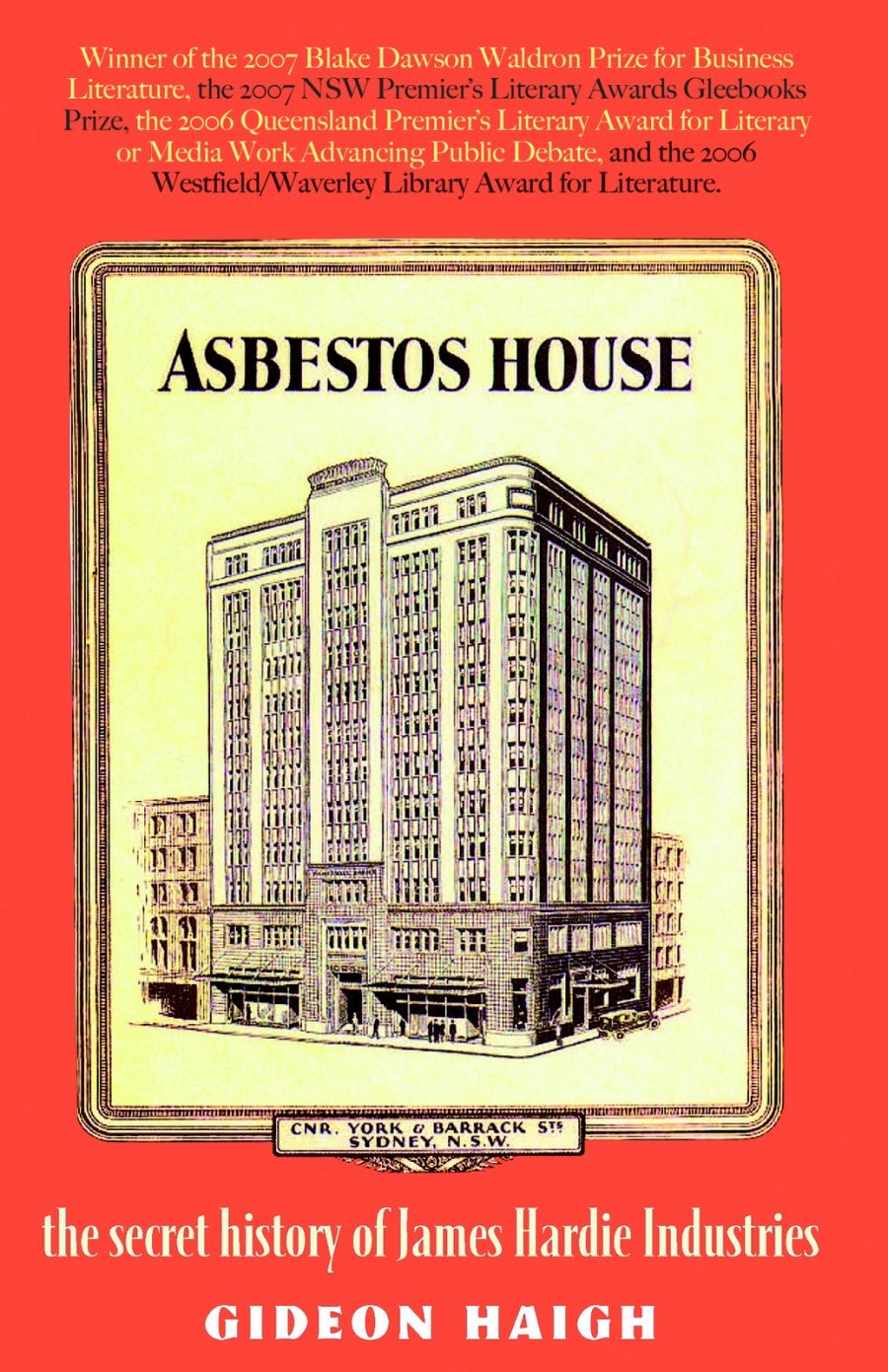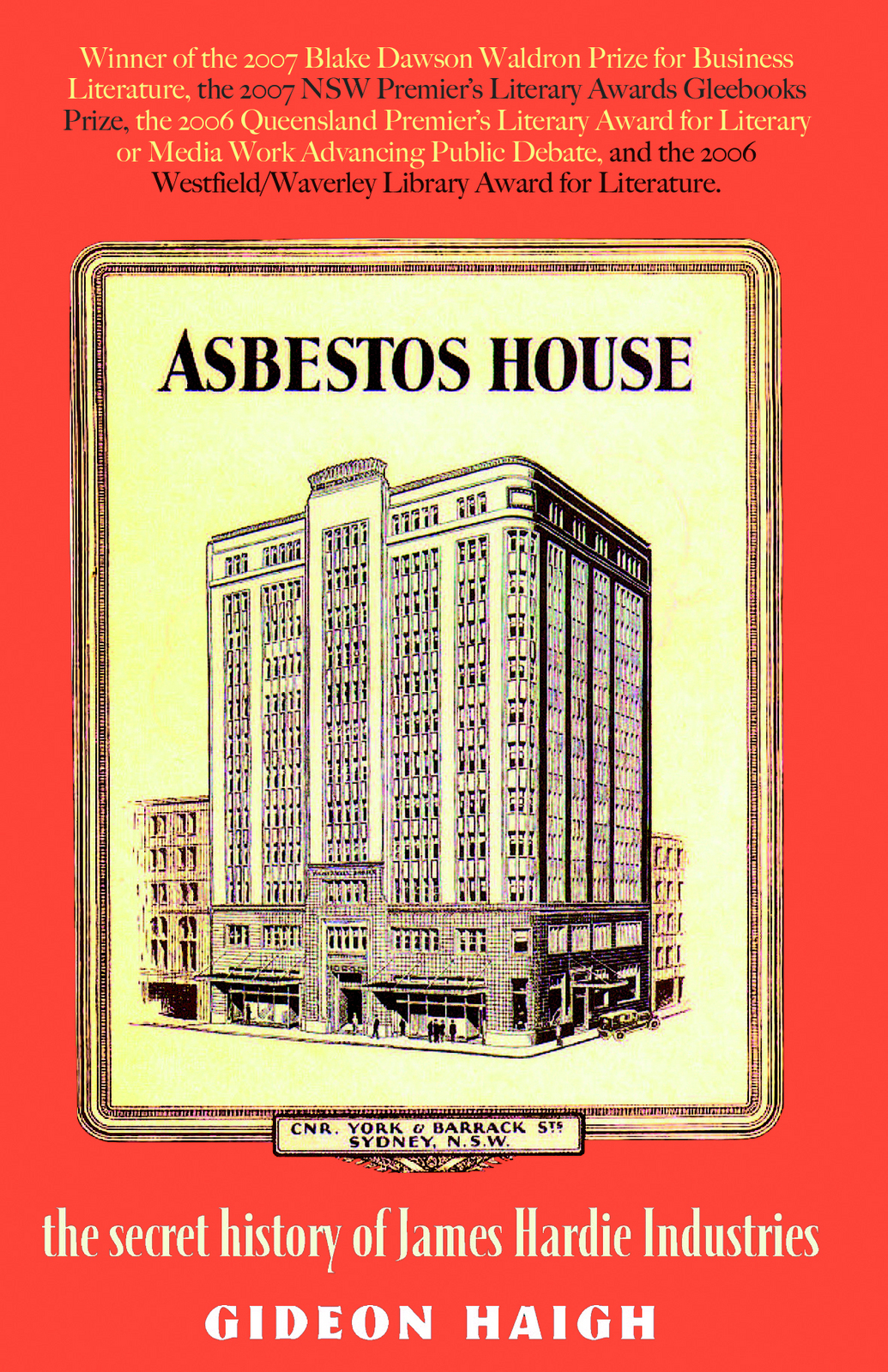
- Free Article: No
- Contents Category: Journalism
- Custom Article Title: Home for hard men
- Review Article: Yes
- Article Title: Home for hard men
- Online Only: No
- Custom Highlight Text:
There is no minimal safe exposure to free asbestos fibre. It is the most lethal industrial material of the twentieth century. Asbestosis and mesothelioma are the common diseases arising from exposure to it. Mesothelioma, a cancer, is distinctively brutal in the way it causes its victims to die. Typically, there are no symptoms for as many as forty years; when the disease appears, death follows after a few excruciatingly painful months. James Hardie, a conservative icon of Australian industry, was established in 1888 and its core business was fibro-cement manufacture, the fibre being asbestos. Gideon Haigh traces the postwar success of the company and its turning away from the gathering evidence of asbestos’s toxicity. Asbestos, it dissembled, was dangerous (like many industrial materials) rather than lethal. Hardie comforted itself in the belief that the incidence of disease reflected past periods of exposure and not the current changed practices. At the same time it failed even to meet these inadequate dust standards in its workplaces.
- Book 1 Title: Asbestos House
- Book 1 Subtitle: The secret history of James Hardie Industries
- Book 1 Biblio: Scribe, $39.95 pb, 448 pp
- Book 1 Cover Small (400 x 600):

- Book 1 Cover (800 x 1200):

By setting up a separate compensation fund and shifting the company’s domicile to the Netherlands, Hardie hoped to put the asbestos issue behind it. However, it grossly under-funded the compensation entity. Haigh makes it clear that Hardie and its advisers were either aware of what they were doing or chose not to know. Action was rationalised in the interests of shareholders, who demanded closure, by capping the fund. This meant the setting aside of resources to fund sufferers, but without contingencies. That is, the only amount to be set aside was the amount that could be actuarially justified. However, no actuarial calculation is going to provide certainty for a sufferer in ten, twenty or forty years. What was clearly indefensible, deceptive and probably actionable, was using out-of-date material, upon which the amount was based.
Not that, in the end, it made much difference. It was soon obvious that the money would run out in a few years, rather than the forty envisaged. Union bands and public outrage, aroused by litigation mobilised by lawyers Slater and Gordon, led to the establishment of the Jackson Special Commission of Inquiry in 2004. The head of the Inquiry, David Jackson QC, determined that the structures that Hardie had established, including the shift of domicile, were in fact legal. Indeed, given its increasingly successful business in the US, Hardie might have chosen to sever its connection with Australia, abandoning its obligations to asbestos sufferers. Although such action appears not to have been seriously contemplated, it is unlikely that no one thought of it. In the event, union boycotts and the general odium in which the company was held led it to comply.
This is a book that should be in any library with a business section. The story is more instructive than tales of colourful villains such as Alan Bond or of corrupt corporations such as Enron. Business books tend to be revelatory, exhortatory and inspirational, when they are not Manichean. Too many business writers seem to have trouble with ambiguity and nuance, indeed with what it is to be human. This is not the case here: Haigh’s is a story of people who were unable, or chose not, to deal with profoundly conflicting interests. Subtle and thorough, it’s a page-turner, particularly the account of the establishment of the original compensation fund, and of the Jackson Inquiry and its aftermath. The reader comes to understand the main players and, in spite of the grubbiness of their activities, to feel sympathy for many. The author may not have intended this. Perhaps predictably, it is the advisers from the big end of town who seem most venal.
The James Hardie saga illuminates that enduring question: how do you run a good business? Haigh’s book spans two eras: postwar nation-building, and the open economy of the past twenty years. After World War II, Australian industry got down to nation-building with energy and idealism. There was bipartisan political support for great initiatives such as the first Holden and the Snowy Mountains Scheme. James Hardie, as a manufacturer of building materials in great demand, was at the heart of this effort. Asbestos cement sheeting was used everywhere. ‘Fibro’ became as iconic as the Hills Hoist or the FJ Holden. The company was honourable and paternalistic. Management made loans to workers of good character. One felt righteous being at the heart of postwar development. Disease from asbestos had to be reconciled with this dream, or ignored. What was lacking was the imagination to deal with a complex reality. Postwar idealism eventually congealed into protectionism and patronage. In the 1980s a new era emerged whose attributes included competition, globalisation, and the primary goal of maximising shareholder wealth. By the late 1990s these worthy ideas were in turn starting to harden. There was increasing focus on the short term. Executive reward bore little relation to achievement. The only things that mattered were what could be controlled and measured. The actions revealed in the Jackson Commission belonged to this period. Both eras failed the victims of asbestos.
Nor did the business environment in either era do much to help James Hardie. For example, there is no evidence in the book of good advice or peer pressure from business colleagues. The reader might speculate on whether other Australian companies would have behaved much differently.
Business is a good home for hard men – people who serve ends with limited regard to means – and they tend to rise to the top. They pay lip service to the ideals of the era and they get on with the job, not necessarily of feathering their own nests. Peer respect, even now, is the most sought-after currency. The people who matter, however, are people of character. There is a role for them everywhere. There are never enough of them, and there were not enough of them at James Hardie.
The current business paradigm appears to be ‘the healthy organisation’, characterised by ‘connectedness’ to employee values and those of the community. This would appear to provide recognition for people of character. It is, after reading this book, easy to be cynical. However, the idea of a healthy organisation seems to embody worthwhile values. Companies that make a success of it might well prosper, and certainly would deserve to.
Perhaps the lesson from this book is that human nature is persistent and that the more business changes, the more it stays the same. There will be more James Hardies, but there will be people who take action and institutions that finally hold wrongdoers to account.
Haigh takes the story to mid-December 2005. The major outstanding item remains the tax-exempt status of the Special Purpose Fund. Funding to a level equivalent to $1.5 billion in present-value terms is envisaged. Annual contributions are capped at thirty-five per cent of cash flow and are to be made for forty years. In late February 2006 James Hardie announced a record half-yearly profit, based on the success of its US business. For the time being, it looks capable of meeting its commitments.


Comments powered by CComment